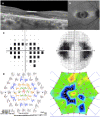Risk factors for hydroxychloroquine retinopathy in systemic lupus erythematosus: a case-control study with hydroxychloroquine blood-level analysis
- PMID: 32442312
- PMCID: PMC8186841
- DOI: 10.1093/rheumatology/keaa157
Risk factors for hydroxychloroquine retinopathy in systemic lupus erythematosus: a case-control study with hydroxychloroquine blood-level analysis
Abstract
Objective: HCQ is an essential medication in SLE, proven to lengthen survival and reduce flares. Its use, however, is limited by its rare but severe ophthalmological complications. Here, we aimed to analyse factors associated with HCQ retinopathy including HCQ blood levels.
Methods: This case-control study compared SLE patients with and without HCQ retinopathy, defined by abnormal results for at least two of the following ophthalmological tests: automated visual fields, spectral-domain optical coherence tomography (SD-OCT), multifocal electroretinogram (mfERG) and fundus autofluorescence. We compared clinical and laboratory findings to assess risk factors for HCQ retinopathy.
Results: The study included 23 patients with confirmed retinopathy (cases) and 547 controls. In the univariate analysis, age (P < 0.001), height (P = 0.045), creatinine clearance (P < 0.001), haemoglobin concentration (P = 0.01), duration of HCQ intake, (P < 0.001), higher cumulative HCQ dose (P < 0.001) and geographical origin (West Indies and sub-Saharan Africa) (P = 0.007) were associated with the risk of retinopathy, while HCQ blood levels were not. In the multivariate analysis, only cumulative dose (P = 0.016), duration of intake (P = 0.039), creatinine clearance (P = 0.002) and geographical origin (P < 0.0001, odds ratio 8.7) remained significantly associated with retinopathy.
Conclusion: SLE patients on HCQ should be closely monitored for retinopathy, especially those from the West Indies or sub-Saharan Africa, or with renal insufficiency, longer HCQ intake or a high cumulative dose. Although reducing the daily dose of HCQ in patients with persistently high HCQ blood levels seems logical, these concentrations were not associated with retinopathy in this study with controls adherent to treatment.
Keywords: concentration; hydroxychloroquine; lupus; retinal toxicity; retinopathy.
© The Author(s) 2020. Published by Oxford University Press on behalf of the British Society for Rheumatology. All rights reserved. For permissions, please email: journals.permissions@oup.com.
Figures
References
-
- Costedoat-Chalumeau N, Amoura Z, Hulot J-S, Lechat P, Piette J-C.. Hydroxychloroquine in systemic lupus erythematosus. Lancet 2007;369:1257–8. - PubMed
-
- Costedoat-Chalumeau N, Dunogué B, Morel N, Le Guern V, Guettrot-Imbert G.. Hydroxychloroquine: a multifaceted treatment in lupus. Presse Med 2014;43:e167–80. - PubMed
-
- Ruiz-Irastorza G, Ramos-Casals M, Brito-Zeron P, Khamashta MA.. Clinical efficacy and side effects of antimalarials in systemic lupus erythematosus: a systematic review. Ann Rheum Dis 2010;69:20–8. - PubMed
-
- Marmor MF, Kellner U, Lai TYY, Lyons JS, Mieler WF.. Revised recommendations on screening for chloroquine and hydroxychloroquine retinopathy. Ophthalmology 2011;118:415–22. - PubMed
Publication types
MeSH terms
Substances
LinkOut - more resources
Full Text Sources
Medical


